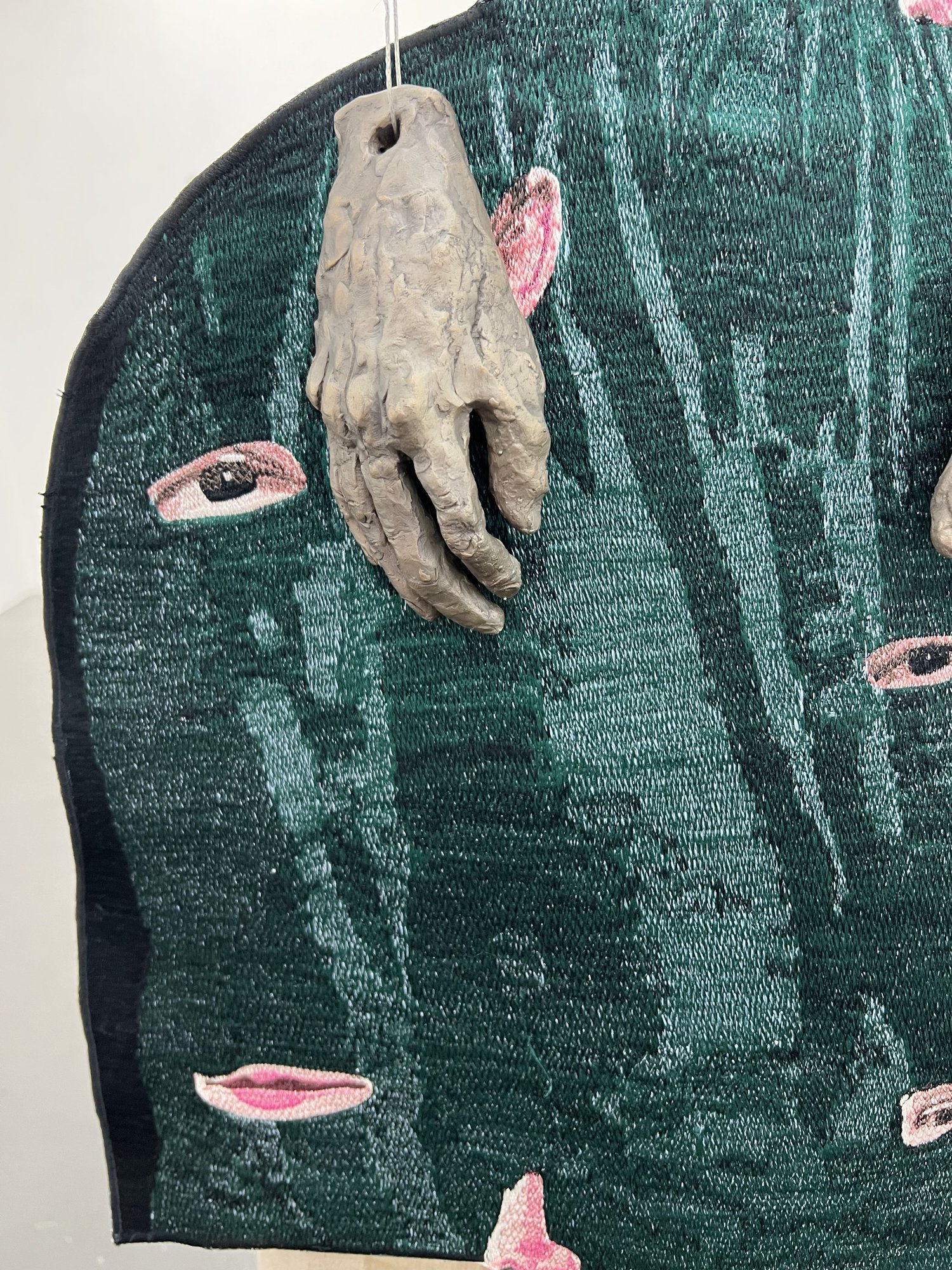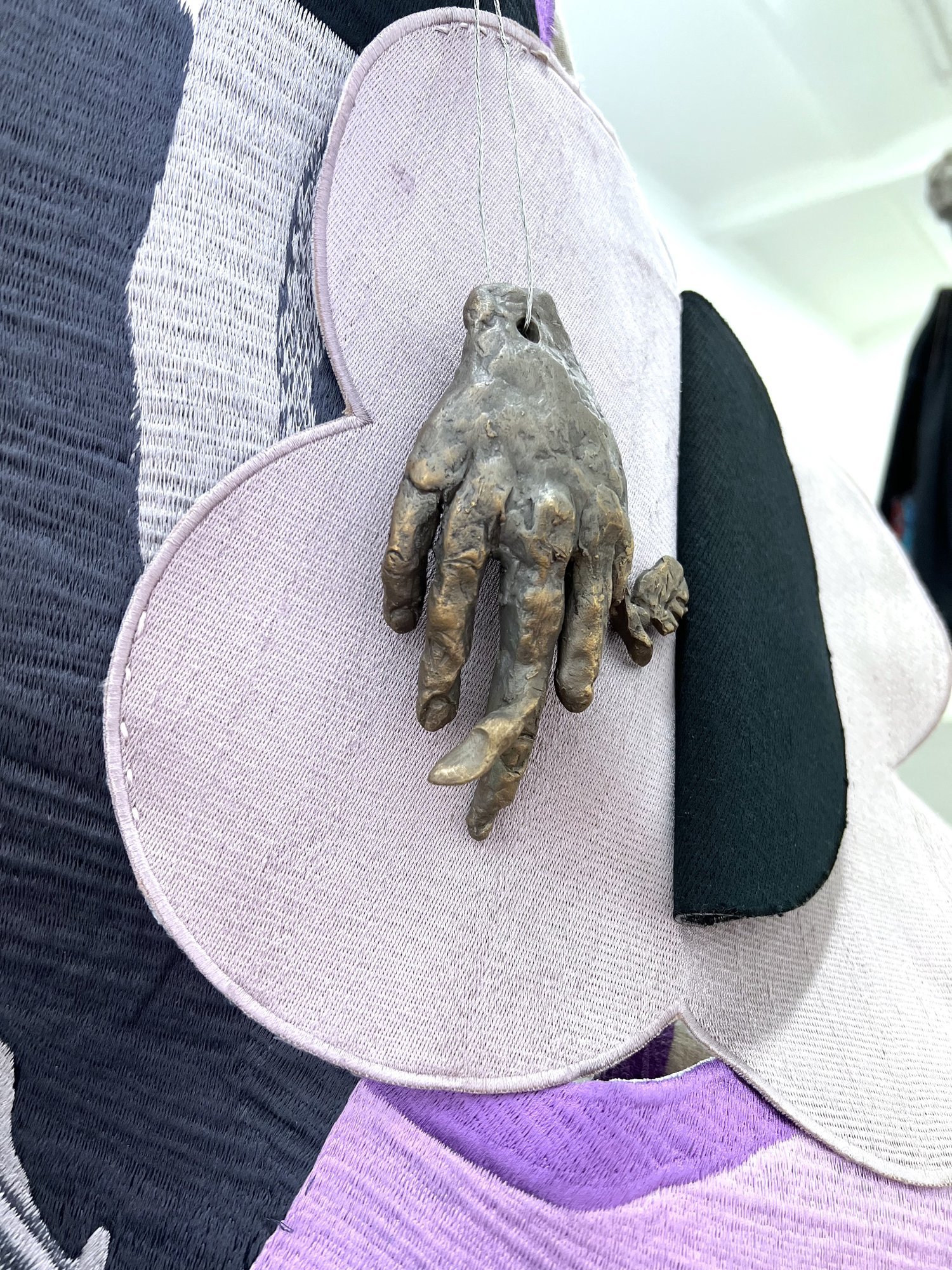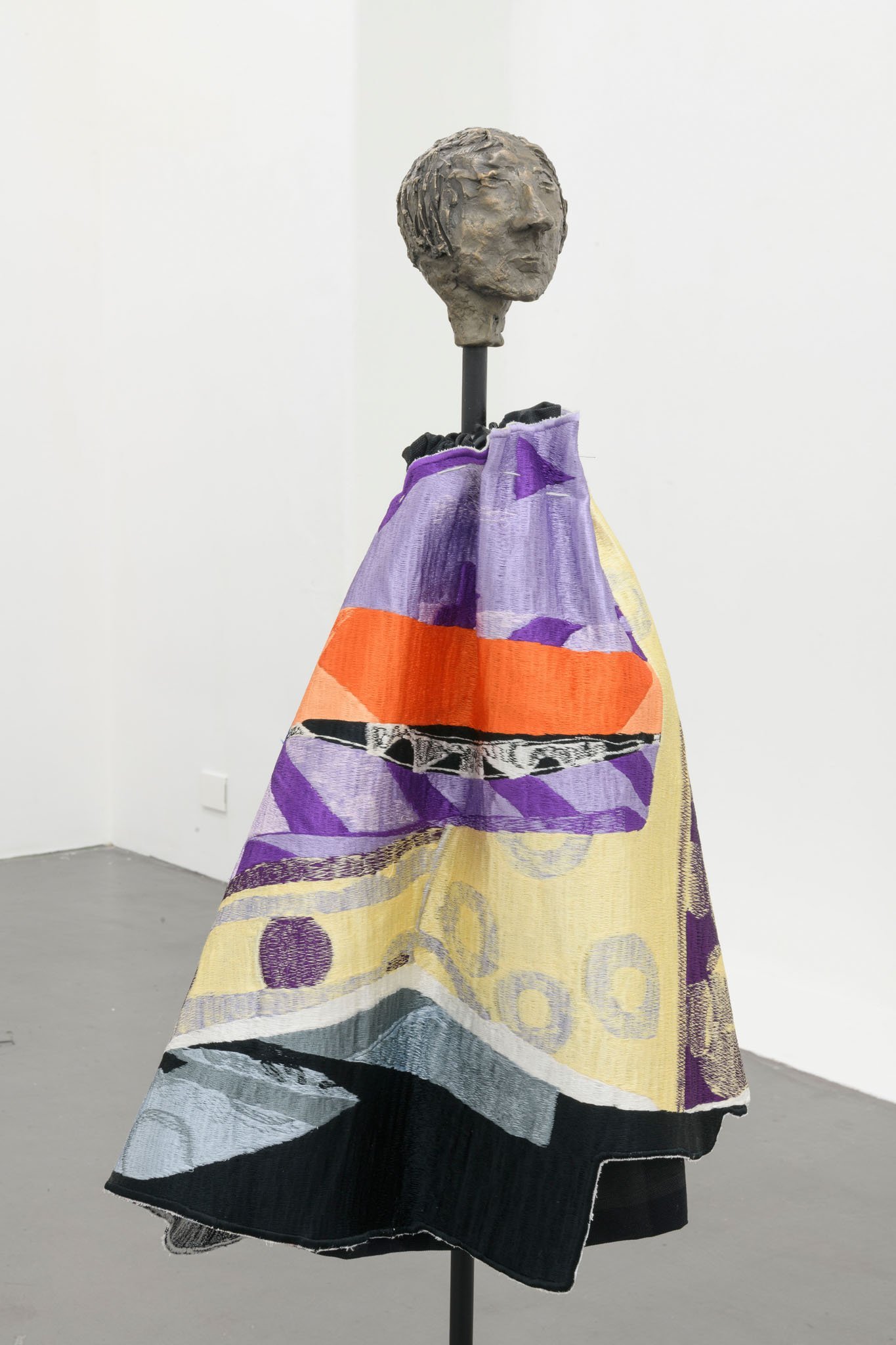
June 2023
Sally Smart
Sally Smart, Sister, 2022-2023, bronze, wax, and embroidery with various textile elements, 63 x 15.75 x 11.75 inches
“Collage and cutting are conceptually the core of my work, providing a way to re-imagine and re-configure.”
—Sally Smart
Camilla Boemio speaks with the assemblage artist about her politically-charged work and a new exhibition at PostmastersROMA.
Sally Smart is one of Australia's most significant contemporary artists, with a practice that engages identity politics. Her practice spans a range of media, and she is known for her large-scale cut-out assemblage installations exploring the imaginary and the uncanny.
Smart's most recent work includes artisan embroideries as assemblage elements. In her project, The Choreography of Cutting, she re-imagines and encapsulates a dynamic discourse between the historical and contemporary avant-garde using experimental performance, costume design, and visual art forms, mapping multiple ideas, temporalities, and space—a materialization of thought/gesture/action.
Smart has received numerous awards and prizes and is currently an Honorary Professor, Faculty of Fine Arts and Music, University of Melbourne.
Camilla Boemio: Please introduce readers to your work and methodology.
Sally Smart: My work combines painting and collage (photomontage, moving images, and drawing) to create large installations that engage with the complexity of multiple histories and temporalities.
Collage and cutting are conceptually the core of my work, providing a way to re-imagine and re-configure. I see cutting as political, which I often refer to as the “politics of cutting.” I developed this approach in the 1990s. It was a methodology to explore the body, using and referencing medical metaphors to dissect and analyze technically and conceptually.
My early works emphasized my interest in political, psychological, and aesthetic dismantling by disrupting the canvas through cut-outs and cut-ups. The materials I use today, involving cutting, pinning, and staining, are still integral to the same underlying conceptual approach.
The ‘cutting’ in various works’ titles references the collage practice (drawing with scissors and blades) but also alludes to my interest in the self-harm neurosis often described as ‘delicate cutting.’ The relationship between the body, thought, and culture and neglected women’s histories are recurring themes in my work.
Sally Smart, The Artists Family (installation view), PostmastersROMA, May 4—June 21, 2023
CB: What artists or movements have influenced you? How does your work reference these influences?
SS: I am influenced by the early avant-garde, especially modernist women artists identified with Cubism, Dada, and Surrealism (Delaunay, Hoch, Popova).
I have examined the meaning (cultural, psychological, political) generated through the movement and the action of cutting, collage, and assemblage. A decade of working with ideas at the intersection of dance and art has resulted in large-scale textile assemblage works drawing inspiration from pioneering dance repertoires of the Ballets Russes to Pina Bausch scenography.
Choreographic techniques connect to the collage methodologies specific to my practice: the movement of elements in space, improvisation, and rehearsal. I re-imagine and re-frame the historical avant-gardes Ballets Russes, its experimental choreography, costume, and theater design, as well as its legacies, through large-scale, richly-colored installations combining textile assemblages and including artisan-made embroideries and screen-printed metal.
Through an interdisciplinary and cross-cultural pursuit of the avant-garde, I am incorporating Indonesian influences informed by the studio I maintain in Yogyakarta (Indonesia), with artisan-created embroideries. I create the textiles from digital collages of cut-up images of Ballets Russes costumes designed by key figures of the historical avant-garde, including Mikhail Larionov, Natalia Goncharova, Pablo Picasso, Henri Matisse, and Sonia Delaunay.
It was a radical idea that Sergei Diaghilev and the Ballet Russes strove for—a synthesis of visual artists, composers, and choreographers to cohere as one defining artwork, a precursor to my way of making art and engaging in collaborative practice.
Sally Smart, Daphne (detail), 2022-2023, bronze and embroidery with various textile elements, 64.1 x 11.75 x 11.75 inches
Sally Smart, Sister (detail), 2022-2023, bronze, wax, and embroidery with various textile elements, 63 x 15.75 x 11.75 inches
CB: You’ve created works questioning gender and identity since the 1990s. Does it feel different thinking about those questions today?
SS: Yes, of course. The issues of the 1990s seemed more theoretical in approaches to art and identity politics in culture. Today, identity politics are powerful actions and forces worldwide, emphasizing a post-colonial world and the interrelated consequences of colonial legacies to human life, race, gender, economics, and the environment.
CB: Having thought and created so much on gender and identity, which are the new frontiers of bodies?
SS: Technoscience and the human body in the time of ecological crisis.
CB: How does place impact your process?
SS: Traveling and exhibiting worldwide allows experimentation and improvisation to flourish in my practice. For example, I have created assemblage compositions in Australia and Indonesia, inspired by the sets and costumes of the historical avant-garde dance company, the Ballets Russes, alongside Indonesian Wayang Kulit theater forms. I have formed extensive relationships with artists and artisans in Yogyakarta, with whom I continue collaborating and engaging in intensive, immersive dialogue and practice.
Sally Smart, Daphne, 2022-2023, bronze and embroidery with various textile elements, 64.1 x 11.75 x 11.75 inches
Sally Smart, Sister, 2022-2023, bronze, wax, and embroidery with various textile elements, 63 x 15.75 x 11.75 inches
Sally Smart, Artist, 2022-2023, bronze and embroidery with various textile elements, 64.1 x 11.75 x 11.75 inches
Sally Smart, Mother, 2022-2023, bronze and embroidery with various textile elements, 60.62 x 16.5 x 11.75 inches
CB: Tell me about your exhibition at PostmastersROMA.
SS: The PostmastersROMA exhibition is titled The Artists Family. All the works are sculptures and embroideries related to Rome, blending history, art, and the everyday.
In 2021, the National Portrait Gallery in Australia commissioned me to consider portraiture. During the Covid-19 lockdown, I experimented with wax modeling heads for a suite of hand puppets influenced by Paul Klee’s modernist puppets. I returned to the idea and started to model heads for a series of ten works—sculptures that used wax plaster and bronze to look at portraits. I did not intend on a particular likeness; the portrait would be discovered through the process. The work evolved through various forms of experimentation into a group portrait with multiple personages, all related as a self-portrait in numerous parts. The heads are different—abstract, animal, and mythological.
CB: Which materials, fragments, and references have you chosen to realize these artworks? How do you build these assemblages?
SS: As the title suggests, the works connect as a family, The Artists Family. There are references to Rome—ancient history and the mythological. In dance and performance with re-imagining De Chirico, Picasso, and Goncharova Ballets Russes costumes, as well as the Commedia dell-Arte’s improvisational theatre with Harlequin and Pulcinella. The sculptures’ heads and hands are primarily cast in bronze from wax models and assembled with embroidery, various other textile elements, and painted steel armatures (stands).
The patchwork process of assembling and stitching together choreography and story parallels the historical origins of the harlequin pattern. The diamond patches were originally textile pieces, more fragmented and scattered, reflecting a state of mind. The Harlequin diamond association continues to appear in the collective imagination during times of chaos and confusion.
Sally Smart, The Artists Ballet Curtain, 2021, digital textile printing with various collage elements, 106 x 118 inches
CB: Can you describe a particular artwork?
SS: Danser Brut (Pulcinella), 2023, is a large embroidery textile based on a 1920 Ballets Russes rehearsal photograph for the ballet Pulcinella. In the story, the Commedia character is carried aloft before a magician comes and resurrects the dead Pulcinella. The brick/stone wall background creates an architectural backdrop to the performance and a collaged image of a brick path covered in colored chalk (I encountered walking). The textile is produced for me by embroidery artisans in Yogyakarta, Indonesia.
The Danser Brut reference in the title references the 2018 exhibition at LaM in Lille and a 2020 project at BOZAR in Brussels that sought to reveal the connections between dance and involuntary or repetitive movements and challenges traditional notions of what constitutes ‘proper’ dance, blurring the boundaries between dance and everyday life. My practice conceptually aligns with Danser Brut through various methodologies and approaches—and a particular interest in constructing images of the bodily represented through psychic states. In Danser Brut (Pulcinella), the improvised performance is implicit.
Sally Smart
The Artists Family
PostmastersROMA
Rome, Italy
May 4 — June 21, 2023








